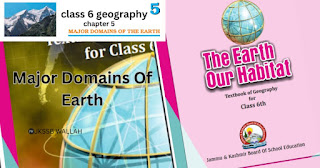class 6 geography chapter 5 questions and answers:Major domains of the Earth ,
Question 1:Answer the following questions briefly.
(a) What are the four major domains of the Earth?
The Earth has four major parts: the solid land (lithosphere), the water bodies (hydrosphere), the air around us (atmosphere), and all living things (biosphere).
(b) Name the major continents of the Earth.
The Earth consists of seven major continents: Asia, Europe, Africa, North America, South America, Australia, and Antarctica.
(c) Name the two continents that lie entirely in the Southern Hemisphere.
The two continents that are entirely located in the Southern Hemisphere are Australia and Antarctica.
(d) Name the different layers of atmosphere.
The atmosphere consists of different layers:
1. Troposphere: The lowest layer where weather occurs.
2. Stratosphere: Above the troposphere, contains the ozone layer.
3. Mesosphere: The middle layer where meteors burn up.
4. Thermosphere: High temperatures, absorbs solar radiation.
5. Exosphere: The outermost layer, merges with space.
(e) Why is the earth called the ‘blue planet’?
The Earth is referred to as the blue planet because approximately 71% of its surface is covered by water, giving it a prominent blue appearance. The remaining 29% of the Earth’s surface is comprised of land.
(f) Why is the Northern Hemisphere called the Land Hemisphere?
The Northern Hemisphere is often referred to as the “land hemisphere” because a significant portion of the Earth’s landmass is situated in this hemisphere.
(g) Why is the Biosphere important for living organisms?
The Biosphere is crucial for supporting life as it encompasses the three essential components: land, air, and water. These components provide habitats and resources necessary for the existence of various living organisms.
2. Tick the correct answers.
(a) The mountain range that separates Europe from Asia is
(i) the Andes
(ii) the Himalayas
(iii) the Urals
(b) The continent of North America is linked to South America by
(i) an Isthmus
(ii) a Strait
(iii) a Canal
(c) The major constituent of the atmosphere by per cent is
(i) Nitrogen
(ii) Oxygen
(iii) Carbon dioxide
(d) The domain of the earth consisting of solid rocks is
(i) the Atmosphere
(ii) the Hydrosphere
(iii) the Lithosphere
(e) Which is the largest continent?
(i) Africa
(ii) Asia
(iii) Australia
Answer 2.
- (iii) the Urals
- (i) an Isthmus
- (i) Nitrogen
- (iii) the Lithosphere
- (ii) Asia
3. Fill in the blanks.
(a) The deepest point on the earth is _____________ in the Pacific Ocean.
(b) The _____________ Ocean is named after a country.
(c) The _____________ is a narrow contact zone of land, water and air that supports life.
(d) The continents of Europe and Asia together are known as _____________.
(e) The highest mountain peak on the earth is _____________.
Answer 3.
(a) The deepest point on the earth is Mariana Trench in the Pacific Ocean.
(b) The Indian Ocean is named after a country.
(c) The Biosphere is a narrow contact zone of land, water and air that supports life.
(d) The continents of Europe and Asia together are known as Eurasia.
(e) The highest mountain peak on the earth is Mount Everest.

